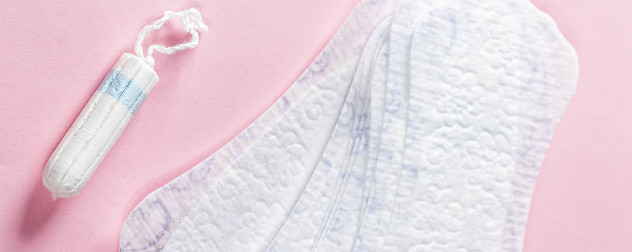Between puberty and menopause, most women (as well as some people of other genders) have regular menstrual periods except during pregnancy. There is nothing embarrassing about talking about menstruation when the subject arises, just as there should be nothing embarrassing about discussing any other bodily function.
The subject of menstruation seldom arises in a blog post written by a man in his 60s. But I’m raising the subject today because of an interesting decision last week by the Scottish parliament. Scotland, which makes its own internal laws as part of the United Kingdom, is the first government in the world to require local authorities to make tampons and sanitary pads available for free to “anyone who needs them,” according to the BBC.
The legislation's primary goal is to end “period poverty,” the situation in which a person who is menstruating is unable to afford appropriate products. The young and the homeless are particularly vulnerable. They may miss work or school, or resort to less suitable means of protection, such as using toilet paper to absorb menstrual blood. Poor menstrual sanitation can put people at increased risk for infections, in addition to the baseline of discomfort it causes. Period poverty, like many other social problems, also has been made worse by the pandemic.
Beyond questions of hygiene, those of potential humiliation and ostracism are no small matter, especially to teenagers. A survey conducted by the charity Young Scot found that almost half of respondents had missed at least some school due to their menstrual cycle. In some places, schools have tried to fill in the gap. Scotland and England already make such products available at school, as so do a few U.S. states, including California and New York. Even where schools already make free products available, though, a sizeable fraction of girls report that they are reluctant to ask for them.
The Scottish government estimates that the new law will cost about 24 million pounds, or about $32 million, per year to provide basic but suitable products. In the context of public health and education budgets, this amount of money is trivially small, especially compared to the benefits of the initiative. I am old enough to remember the tragedy of toxic shock syndrome that accompanied the introduction of extended-wear tampons at the end of the 1970s. The prolonged use of a tampon can foster the growth of toxin-producing bacteria to which a minority of otherwise healthy tampon users are particularly vulnerable. The type of tampon that led to the initial, widely publicized TSS outbreak has long since been withdrawn. But TSS is not unknown even today. It does not take any personal experience with menstruation to realize that someone who cannot afford to change tampons frequently is more apt to use fewer for longer. This behavior raises the risk of a life-threatening TSS reaction.
Some might wonder why the public purse should support so personal a need. The answer can be found in any stall in any public bathroom. We expect any place providing those facilities to provide toilet paper, and we certainly notice when it is not there. The paper addresses a biological fact of life. Menstruation is exactly the same sort of biological fact. The need for one type of product is as universal as the need for the other, apart from the distinction that menstruation occurs only in those of us with a uterus.
If the public is going to provide period products, we might wonder whether anyone will bother to buy their own. I wouldn’t worry about that, either. Again, look to public bathrooms: We all use them when we need to, but few people bother to steal the toilet paper from them. (Most of us don’t particularly begrudge or worry about the people who find themselves in a position where they must, either.) Those of us who can afford more upscale products often prefer them for home use. I am no expert on menstrual products, but I expect it will be pretty much the same with them. Besides buying higher-quality disposable products, a small but growing number of customers are turning to sustainable options, which the free supplies wouldn’t replace.
The British term for the regional governments in Scotland, Wales and Northern Ireland is that they are “devolved” from London, which governs the part of the United Kingdom known as England. But the Scottish legislation on period products, which ultimately passed with unanimous support, seems highly evolved when seen from this side of the pond. I would not object at all if we choose to catch up.















December 4, 2020 - 8:10 am
Hello Larry, I read your article with great interest. I agree with providing free menstrual products, especially for women and girls who can’t afford them. I wonder though, who is responsible in law, if somebody gets Toxic Shock Syndrome. Nearly all main brand tampons are made of a blend of RAYON (a highly absorbent material) and cotton (not so absorbent). TSS occurs when the bacteria (already in the vagina quite harmlessly) reacts with the RAYON. The symptoms of TSS can occur within 2 hours of inserting a tampon. Since you (along with many others who perhaps have never seen a case of TSS) have perpetuated the myth that TSS is caused by the extended length of use of tampons, it would be safer all round if only ALL-COTTON tampons along with pads/towels are provided free of charge to the public.
December 4, 2020 - 10:17 am
While exceedingly rare these days, toxic shock syndrome is a risk no matter what sort of tampons you use. A 2018 study in the American Society for Microbiology (https://aem.asm.org/content/84/12/e00351-18.abstract) confirmed that 100% cotton tampons still carry a slight TSS risk, as do menstrual cups. (More coverage here: https://www.chicagotribune.com/lifestyles/health/sc-hlth-toxic-shock-syndrome-tampons-0425-story.html ) I’m all for making a variety of types of products available so users can make their own choices, but tampon users should still stay alert for symptoms and change their products regularly, regardless of the brand or materials.